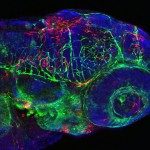Link to Pubmed [PMID] – 16386394
Hear. Res. 2006 Mar;213(1-2):1-10
In teleosts, the lateral line system is composed of neuromasts containing hair cells that are analogous to those present in the inner ear of all vertebrates. In the zebrafish embryo and early larva, this system is composed of the anterior lateral line (ALL), which covers the head, and the posterior lateral line (PLL), present in the trunk and tail. The mechanosensory hair cells found in neuromasts can be labeled in vivo using fluorescent dyes such as 4-di-2-Asp (DiAsp) or FM1-43. We have studied the effects of water-borne copper exposure on the function of the lateral line system in zebrafish larvae. Our results show that transient incubation of post-hatching larvae for 2h with non-lethal concentrations of copper (1-50 microM CuSO4) induces cellular damage localized to neuromasts, apoptosis, and loss of hair cell markers. This effect is specific to copper, as other metals did not show these effects. Since hair cells in fish can regenerate, we followed the reappearance of viable hair cells in neuromasts after copper removal. In the PLL, we determined that there is a threshold concentration of copper above which regeneration does not occur, whereas, at lower concentrations, the length of time it takes for viable hair cells to reappear is dependent on the amount of copper used during the treatment. The ALL behaves differently though, as regeneration can occur even after treatments with concentrations of copper an order of magnitude higher than the one that irreversibly affects the PLL. Regeneration of hair cells is dependent on cell division within the neuromasts as damage that precludes proliferation prevents reappearance of this cell type.

